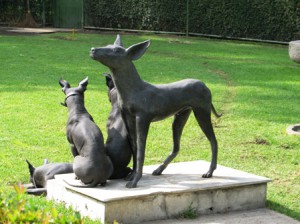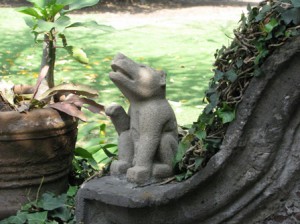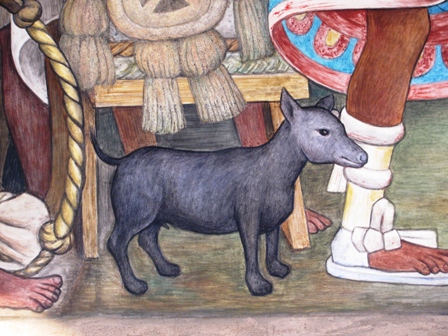What’s that they say about a little knowledge? I knew the Aztecs ate dogs. I knew they kept a hairless breed of dog. So I naturally assumed they bred the hairless breed for food. So much more convenient not having to deal with all that hair in the kitchen.
 Wrong. I’m sure there’s a name for this kind of logical fallacy. Be that as it may, a recent visit to the Dolores Olmedo Patiño Museum, in Xochimilco, Mexico City, where they keep a pack of that hairless breed, which is called Xoloitzcuintle by the way, quickly disabused me. A notice there points out that the name Xoloitzcuintle makes reference to Xolotl, a god associated with death (among other things). Dogs were supposed to accompany the dead on their way to the next world. Not the done thing to eat them, then, surely. It must have been other breeds that were eaten.
Wrong. I’m sure there’s a name for this kind of logical fallacy. Be that as it may, a recent visit to the Dolores Olmedo Patiño Museum, in Xochimilco, Mexico City, where they keep a pack of that hairless breed, which is called Xoloitzcuintle by the way, quickly disabused me. A notice there points out that the name Xoloitzcuintle makes reference to Xolotl, a god associated with death (among other things). Dogs were supposed to accompany the dead on their way to the next world. Not the done thing to eat them, then, surely. It must have been other breeds that were eaten.
 Well, maybe. The Wikipedia article on Xolotl says that “the meat of the Xoloitzcuintle was very much part of the diet of some of the ancient peoples of the region.” There’s no reference for that, though. What seems clear is that there were, indeed, other dog breeds. Many of the representations of dogs don’t really look like the Xoloitzcuintle at all. Squatter and fatter. Dare I say it? Jucier. There are many of them, mainly in pottery, at the museum, though I was not allowed to photograph the ones indoors.
Well, maybe. The Wikipedia article on Xolotl says that “the meat of the Xoloitzcuintle was very much part of the diet of some of the ancient peoples of the region.” There’s no reference for that, though. What seems clear is that there were, indeed, other dog breeds. Many of the representations of dogs don’t really look like the Xoloitzcuintle at all. Squatter and fatter. Dare I say it? Jucier. There are many of them, mainly in pottery, at the museum, though I was not allowed to photograph the ones indoors.
Diego Rivera seems to have had a thing about Aztec dogs, by the way. He painted them a number of times. Here’s an example from the Palacio Nacional mural. Interestingly, though, they look a lot more like the pottery pieces than the actual Xoloitzcuintle specimens roaming around the gardens of his friend Dolores’ house.
